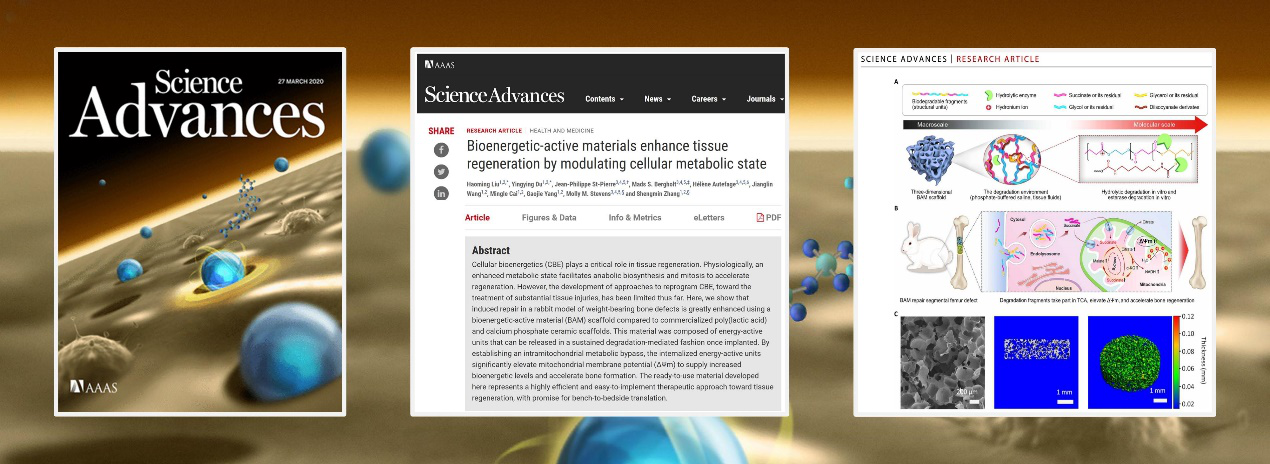On March 25, 2020, Science Advances, the famous journal of Science series, reported the original discovery of Prof. Shengmin Zhang's team of Huazhong University of Science and Technology (HUST) with the cover highlight: Bioenergetic active materials enhance tissue regeneration by regulating cellular metabolic state. The cover emphasized that the findings demonstrated a new horizon in biomaterials science and regenerative medicine.
In the past 100 years, biomedical materials have been classified into bioinert materials, bioactive materials, and biodegradable materials, etc. In particular, biodegradable materials are considered as the important basis of tissue engineering and regenerative medicine, which makes it possible to repair and regenerate massive defective human tissues and organs. Generally, there are three elements for tissue engineering realization: scaffold, seed cells, and growth factors. Bioenergetic-active Material (BAM) is a kind of new concept biomaterial originally proposed by Prof. Shengmin Zhang’s team at HUST. The major advantage of BAM over existing bioactive and biodegradable materials is that its degraded molecular fragments can directly participate in the tricarboxylic acid cycle in the mitochondria and increase the cellular energy metabolism level in situ, which significantly promotes the reconstruction and regeneration of defective tissues and organs. However, PLA, PLGA, PCL, and other commonly used biodegradable biomaterials approved by FDA cannot participate in the tricarboxylic acid cycle through their degradation products. The typical in vivo tissue repair and reconstruction experiments showed that BAM can induce twice the amount of new bone under the same conditions. Therefore, the bioenergetic-active materials play the dual role of tissue scaffold and "growth factor" in tissue reconstruction. It has the functions of degradable materials and cell/gene active materials, thus exhibits the characteristics of a kind of “Super Biomaterials” and important application prospects in the field of repair, regeneration, and rapid reconstruction of massive defective tissues and organs caused by serious diseases and disasters.

Figure 1. The cover highlight of Science Advances in March 2020 reported that Prof. Shengmin Zhang's team pioneered bioenergetic-active materials, showing a new horizon of biomaterials science and regenerative medicine. The degraded fragments of bioenergetic-active materials can directly participate in the tricarboxylic acid cycle in mitochondria, and improve the cellular energy metabolism level in situ, thus significantly promoting tissue construction and regeneration
To realize the application of the new findings and truly solve the clinic problems, Prof. Shengmin Zhang's team started the industrial translation of the project as early as their independently obtaining the patents authorizations. At present, the HUST team has worked together with the national high-tech enterprises in Biolake, and developed the first- and second-generation of implantable medical devices, and will start product ways to the authorizations of NMPA, FDA, and MDR in China, the United States, and the European countries, respectively. This important progress shows that the HUST team is more than five years ahead of the world's multinational companies in the specific fields.
The first authors of the paper published in Science Advances are Dr. Haoming Liu and Dr. Yingying Du from Huazhong University of Science and Technology, and Prof. Shengmin Zhang is the corresponding author. Prof. Molly Stevens of Imperial College London, Fellow of the Royal Academy of Engineering, is the co-corresponding author.
This work was funded by the National Natural Science Foundation of China, the National Key R & D Project, and the HUST Key Innovation Team Project for Interdisciplinary Advancement on Biomaterials and Regenerative Medicine, and the grants of the UK Regenerative Medicine Platform.